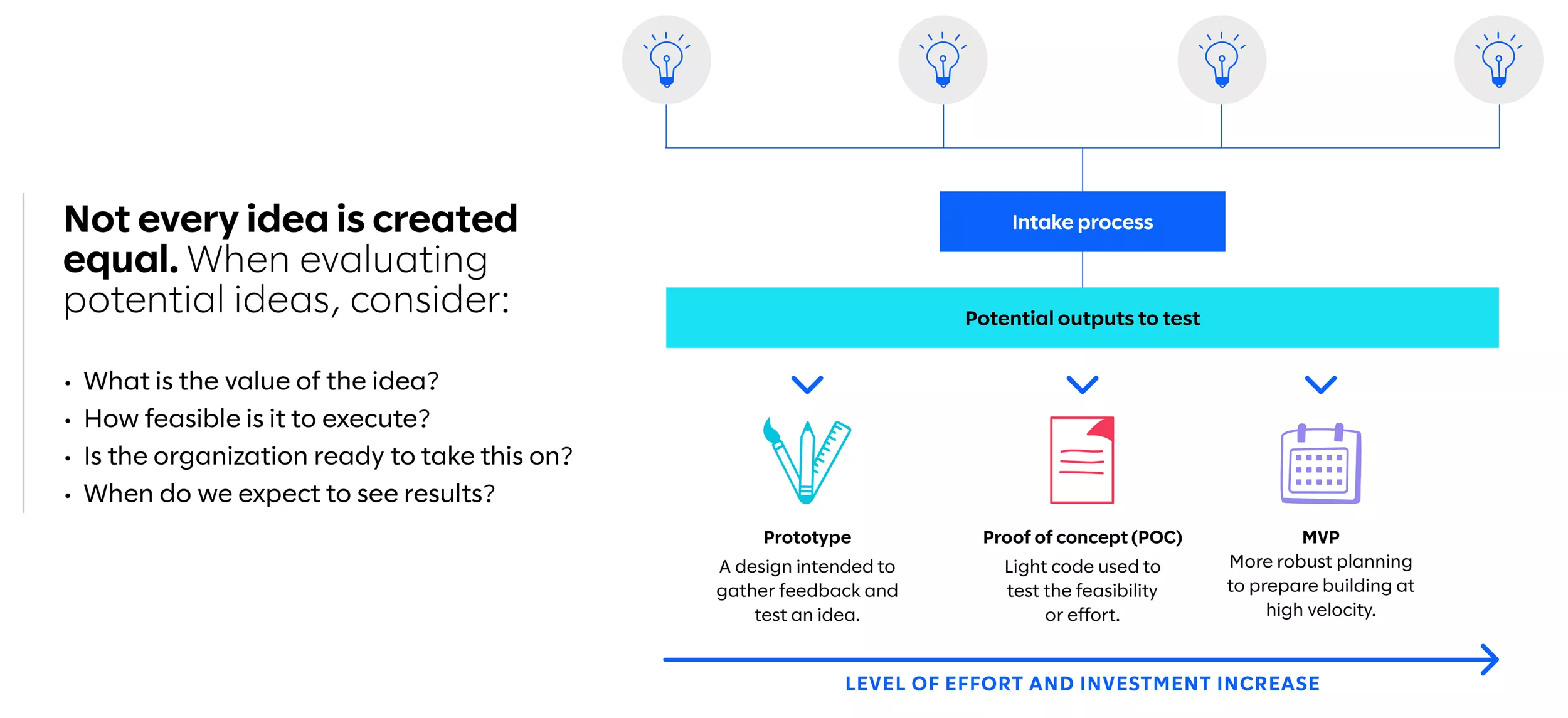AI and innovation: Transform ideas into impact in weeks

Since ChatGPT hit the open market over a year ago, how many ideas have your team members shared about leveraging generative AI? Over 100? 200?
More importantly, how many of them were relevant or implemented?
With the growing popularity of generative AI, a question looms large for business leaders: How can you harness this wave of technological potential to capture, prioritize, and execute ideas swiftly and effectively?
It starts with bringing innovation from theory to reality.
“Innovation is no longer managed by a siloed team nor is it a catchy term to throw out in meetings and presentations,“ says Ali Minnick, Slalom’s global head of business advisory services. “It should be a constant practice in every organization.“
Unquestionably, 2023 was the year of experimentation. As you settle into 2024 and start planning for 2025, your stakeholders will expect regular evidence that your ideas and experiments are generating results.
A structured and measurable approach to innovation is now as critical to your company’s future as finance, marketing, sales, or IT. It's time to establish your organization’s approach to innovation that enables you to support and grow ideas while helping you measure the ROI.
An approach that generates energizing results
We recently partnered with a large renewable energy company that wanted to methodically test, measure, and build their most innovative ideas for AI. This company has an ambitious and incredibly important goal: a decarbonized future.

By building a process to rapidly mobilize innovation, Slalom helped the organization begin driving impact to the areas that matter most:
Their business
In eight weeks, they identified and prioritized 36 use cases, representing tens of millions of dollars in business value. They now have a process for rapidly scaling the right ideas across the organization and, most importantly, business cases for every idea moving into production.Their customers
Through the betterment of the world and a vision of a brighter future, this company’s goal affects all of us. By implementing an end-to-end innovation process, they can test and prioritize life-altering use cases to drive renewable energy growth more quickly.Their people
Your best ideas are fueled by your people. A large part of this effort was evolving their talent strategy and empowering their people to play a crucial role in generating ideas and bringing them to life. They now have a recruiting engine to help drive the culture and brand of their innovation hub and a clearer view of talent needs. The daily focus on innovation also helped existing team members develop new ways of working and thinking.
Making it real
According to our research, roughly seven in 10 executives plan to increase investments in AI innovations in 2024. That said, Forbes estimates that roughly 50% of innovation outcomes don’t live up to expectations. So how do you ensure that you’re investing in the right ideas from the outset?
We call this proven approach to quickly realizing the value from innovation “The Impossible Factory.“ This method helps companies build the foundation for rapid prototyping, testing, and scaling of innovative ideas. By getting hands-on with strategy from the outset, businesses can measure the value generated from their innovation efforts at every step of the process.

This approach focuses on five main objectives:
The ability to generate and refine ideas
Every team in your organization should be generating ideas, especially those closest to your customer or end user. To encourage employees at all levels to contribute their insights and ideas for new use cases, you need a system that makes it easy to submit ideas and a process for scoping and refining them.Alignment to strategic priorities
Not all ideas are created equal, which is why it’s crucial to align and prioritize ideas based on your company and customer strategy. This ensures that you’re allocating resources efficiently and addressing the most valuable ideas first. This framework also validates and prioritizes milestones along the roadmap.Clear line of sight into ROI
Each idea should start with a value hypothesis. If this idea is brought to life, what will you unlock? What impact will it have? By clearly defining expected value up front and monitoring it at every milestone, you can keep a close eye on potential ROI. If something’s not performing as it should, it may be time to deprioritize and move on to another idea.Rapid prototyping
Assumptions and unknowns equate to risk. By rapidly testing ideas, you’re determining what to invest in and scale. It’s an iterative process that helps you quickly identify viable solutions without wasting time on concepts that don’t produce value. Focusing on lower-fidelity outputs during the testing process helps you get to a decision faster.Enablement through governance and cross-functional teams
By using governance to monitor and mitigate risks, you’re providing a safety net for experimentation. This gives your cross-functional team of designers, engineers, strategists, and domain experts the opportunity to refine, measure, design, and deliver ideas quickly while also iteratively improving your governance model.

Your company’s approach should support these objectives to not only generate ideas but quickly move the best ones forward and accelerate your time to value. This focus will lead to a continuous, sustainable innovation model that allows you to anticipate the needs of your customers, offer products and services that grow your bottom line, and keep your best people engaged and involved in the process.
Innovation isn’t optional
There will be more innovations in the next year than we saw in the last decade. This surge in technological advancement gives leaders the opportunity to rethink what they want their company to look like in the future. Innovation can’t be a separate function that’s disconnected from day-to-day decision-making—it needs to become a core part of the business.
Implementing a structured and sustainable innovation approach breaks down communication barriers across stakeholders, allowing for early alignment and faster decision-making. It allows you to design and deliver real, measurable value at a disruptive pace and lower cost.
Embrace the opportunity to build a more viable future by bringing innovation into your day-to-day—for your business, customers, and employees.
This article was written by Slalom in support of our partnership with Fortune. Visit the Slalom-sponsored AI hub spotlighting the companies using AI to change the world for the better and exploring how technology and innovation can address society’s biggest challenge.




